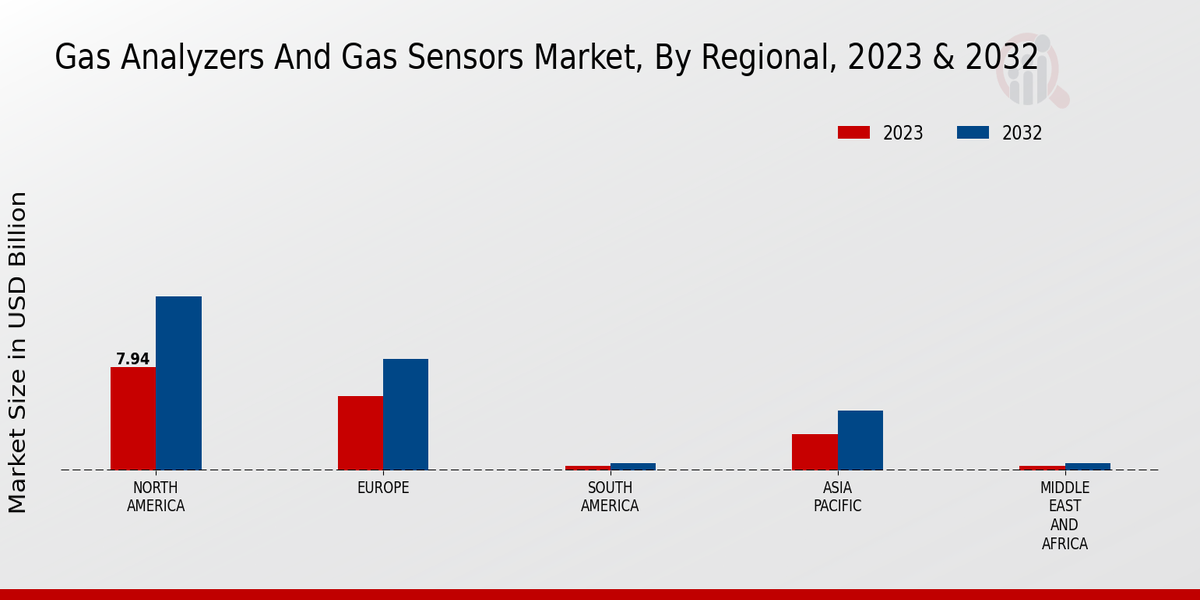Expansion of the Oil and Gas Sector
The expansion of the oil and gas sector is a significant driver for the Gas Analyzers and Gas Sensors Market. As exploration and production activities increase, the need for effective gas monitoring solutions becomes paramount. Gas analyzers are crucial for detecting hazardous gases during drilling and refining processes, ensuring the safety of personnel and equipment. The oil and gas industry is expected to invest heavily in advanced gas detection technologies, with estimates suggesting a market growth of approximately 8% in this sector over the next few years. This growth is driven by the necessity for enhanced safety measures and compliance with environmental regulations, further solidifying the role of gas analyzers and sensors in this critical industry.
Increasing Industrial Safety Regulations
The Gas Analyzers and Gas Sensors Market is experiencing a surge in demand due to the increasing emphasis on industrial safety regulations. Governments and regulatory bodies are implementing stringent safety standards to mitigate risks associated with hazardous gases in various sectors, including manufacturing, oil and gas, and chemical processing. This regulatory landscape compels industries to adopt advanced gas analyzers and sensors to ensure compliance and enhance workplace safety. For instance, the Occupational Safety and Health Administration (OSHA) has established guidelines that necessitate the use of gas detection systems in confined spaces. As a result, the market for gas analyzers and sensors is projected to grow, with an estimated increase of 6% annually over the next five years, driven by the need for compliance and safety assurance.
Rising Demand in Healthcare Applications
The Gas Analyzers and Gas Sensors Market is witnessing a notable increase in demand within healthcare applications. The need for precise gas monitoring in medical settings, such as hospitals and laboratories, is becoming increasingly critical. Gas analyzers are essential for monitoring anesthetic gases, oxygen levels, and other critical parameters in patient care. The healthcare sector's growth, coupled with advancements in gas detection technologies, is expected to propel the market forward. According to industry estimates, the healthcare segment is projected to account for approximately 20% of the total market share by 2026, reflecting the importance of gas analyzers and sensors in ensuring patient safety and effective medical procedures.
Growing Awareness of Environmental Issues
The Gas Analyzers and Gas Sensors Market is significantly influenced by the growing awareness of environmental issues. As concerns regarding air quality and greenhouse gas emissions escalate, industries are compelled to adopt gas detection solutions to monitor and mitigate their environmental impact. Regulatory frameworks aimed at reducing emissions are becoming more prevalent, prompting companies to invest in gas analyzers and sensors to ensure compliance. For instance, the Environmental Protection Agency (EPA) has established regulations that require continuous monitoring of emissions from industrial sources. This trend is likely to drive the market, with projections indicating a growth rate of around 5% annually as organizations prioritize sustainability and environmental responsibility.
Technological Advancements in Gas Detection
Technological advancements are playing a pivotal role in shaping the Gas Analyzers and Gas Sensors Market. Innovations such as the development of miniaturized sensors, wireless communication capabilities, and enhanced data analytics are transforming the landscape of gas detection. These advancements enable real-time monitoring and data collection, which are crucial for industries that require immediate responses to gas leaks or hazardous conditions. For example, the integration of IoT technology in gas analyzers allows for remote monitoring and alerts, significantly improving operational efficiency. The market is expected to witness a compound annual growth rate (CAGR) of approximately 7% over the next few years, as industries increasingly adopt these advanced technologies to enhance safety and operational performance.

















Leave a Comment